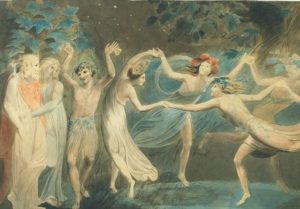This is a crosspost by L. A Smith from The Traveller’s Path

One of the intriguing questions about the Anglo-Saxons who lived in England in the Early Middle Ages revolves around their religious beliefs and mythologies. Pretty much all of what we know of these beliefs were written down by Christian monks, and so it’s tricky to tease out the truth of that second-hand information. Bede gives us some glimpses of their religion, but by the time he was writing his Ecclesiastical History of the English People, completed around 731 AD, the religious practices of the pagan Anglo-Saxons had pretty much disappeared from England, so he was writing about beliefs and practices that were pretty much legend in his time.
The Anglo-Saxons of the 7th century* were, of course, descended from the Angles, Saxons, and Jutes who migrated to Britain after the Romans left the island defenceless in the 4th century. There is considerable discussion about whether these migrants came as conquerors or settlers, and the truth is likely a mix of the two.
These groups of people came with their own set of beliefs and worldview that were distinct from those of the Celtic and Romano-British people who populated Britain at the time. They were Germanic people, and shared the rich heritage of the Norse and Germanic religions. They certainly were not Christians, but encountered a strong thread of Christian culture in Britain, a legacy of the Roman occupiers.
So in trying to determine the religion and mythologies of the pagan Anglo-Saxons, scholars and historians look to the beliefs of their contemporary Germanic and Norse kin who lived on the Continent during the time they settled in Britain. But of course, their culture and beliefs slowly diverged from their Continental neighbours as time passed, and as they began to be integrated with the local population.
I don’t have the time or expertise to cover all of the Anglo-Saxon beliefs and mythology, but I thought I could give a brief overview of their mythologies about elves, seeing as I did some research on this in writing my first novel, Wilding: Book One of the Traveller’s Path(coming early 2019).
Much has been made of Tolkien’s elves, and many scholars with far more expertise than I have written about Tolkien’s understanding of the Saxon myths and religion and how he incorporated that into his Middle Earth (itself an Anglo-Saxon term) and his conception of elves.
I have posted before about how the concept of “elves” is a feature in many different cultures’ mythologies across the world. In that post I wrote:
Featured image: Oberon, Titania and Puck with Fairies Dancing, by William Blake (1786) This painting comes from the 18th century, but I think that it is actually not a bad depiction of Anglo-Saxon elves! Image from sussexarch.org.



Would it be too impudent to ask if the Battle of Heavenfield (about which I see you have written in a couple earlier posts) features in your novel? I was struck in reading chapter six of Tolkien’s The Book of Lost Tales, Part Two (1984) how attention to “A great battle between Men at the Heath of the Sky-roof” enters into his early thinking about direct Anglo-Saxon contact with Elves, and suppose this refers to Heavenfield (which he mentions by name in “Beowulf: The Monsters and the Critics”), though I can’t recall anyone explicitly discussing this.
One can appreciate the occasional glimpses he gives of wishing more Anglo-Saxon Elven lore – and even tales – had in fact survived in writing.
Hi David,
My book does not cover the Battle of Heavenfield, as it takes place after Oswald’s death and his brother Oswy gains the throne.
I also wish that more Anglo-Saxon elven lore survived. We have so little written material from them. There’s a lot we just don’t know.